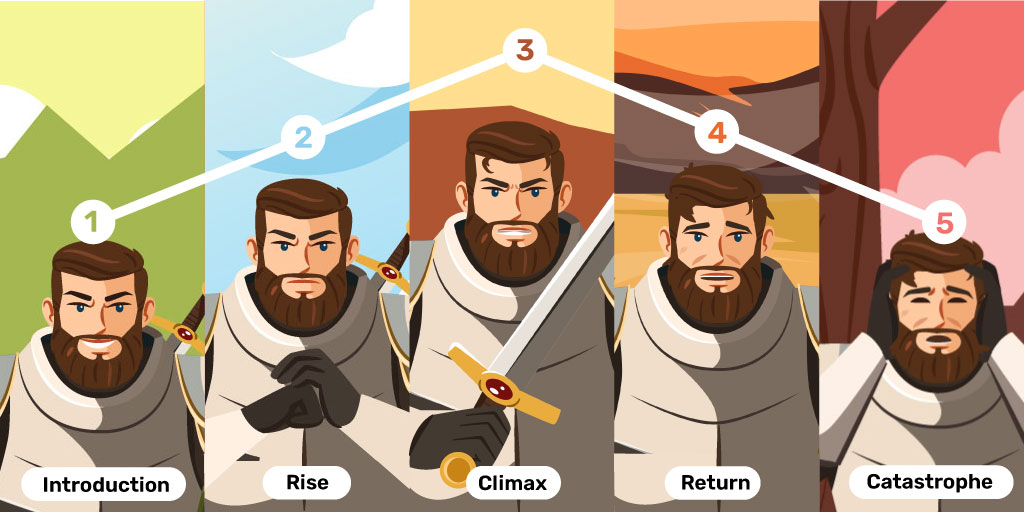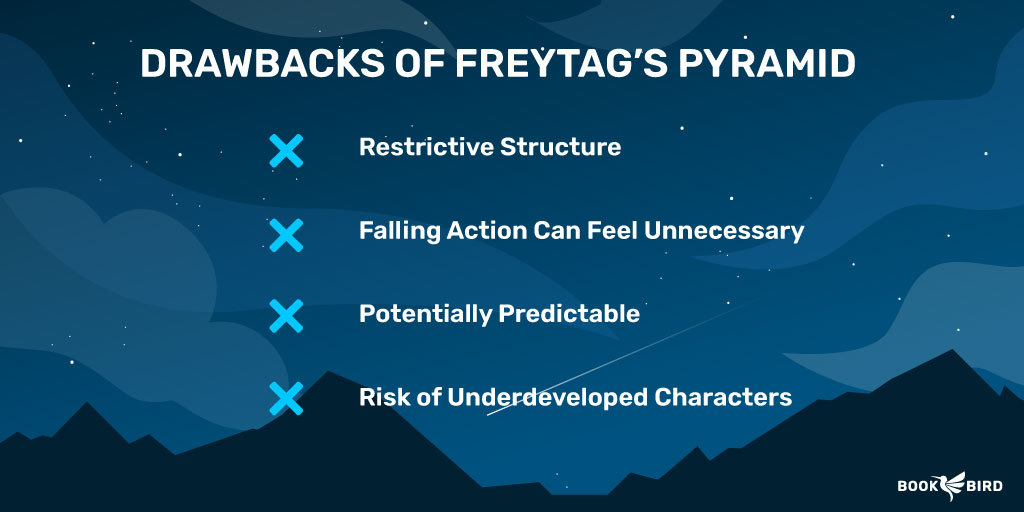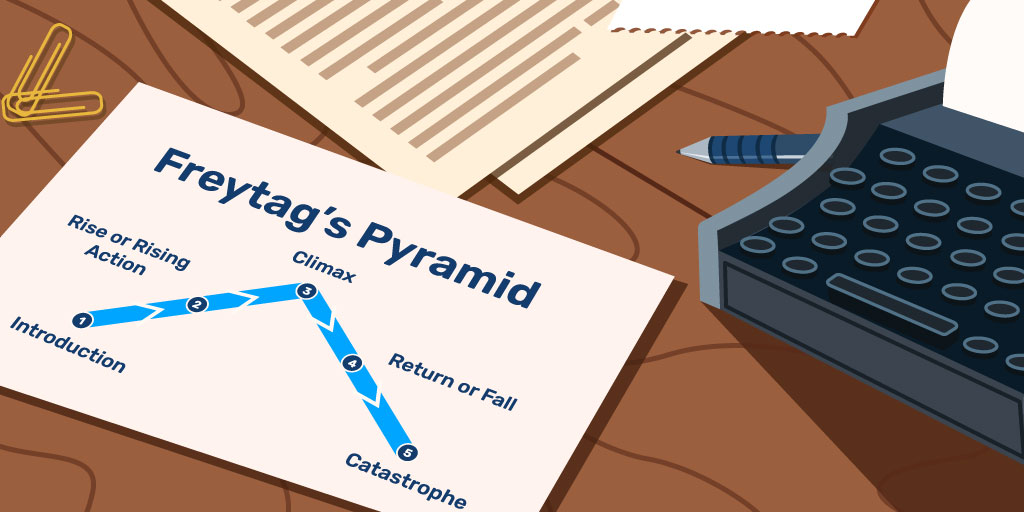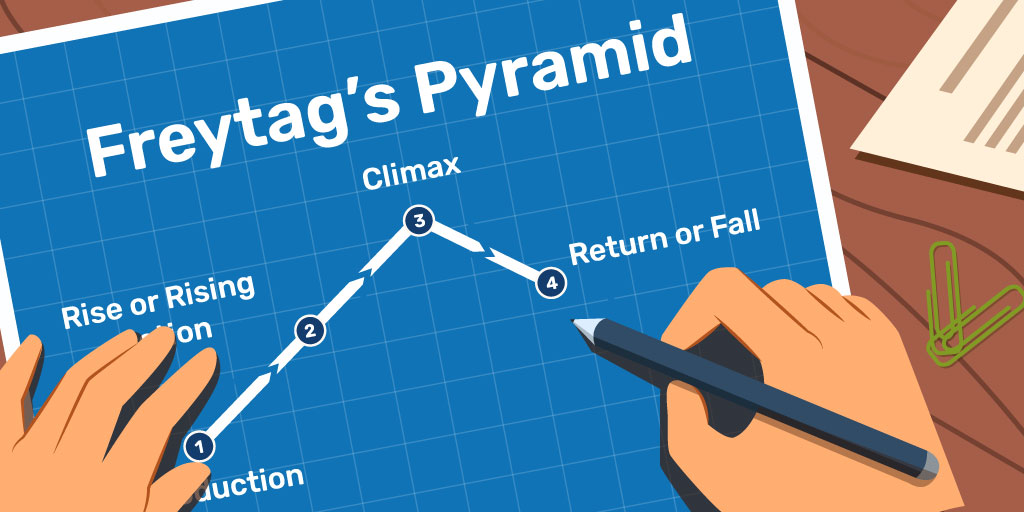Freytag’s Pyramid is a powerful tool for crafting compelling stories. It’s a structure that writers have used for centuries to create narratives that capture the hearts and minds of their readers. At the base of the pyramid lies the exposition. As we climb higher, the tension builds, leading to a climax that leaves us breathless. And as we descend, we are left with a sense of resolution and closure.
In this guide, we will explore the intricacies of Freytag’s Pyramid and how it can be used to create stories that resonate with readers emotionally. So, join us on this journey to learn about this specific form of storytelling.
What Is Freytag’s Pyramid?

Freytag’s Pyramid is a framework that analyzes and outlines the dramatic structure of stories from beginning to end. Its steps map the rise and fall of tension and emotion within a story.
It was developed by Gustav Freytag, a German playwright and novelist of the nineteenth century. In his seminal work, “The Technique of the Drama,” Freytag uncovered the underlying principles that made certain plays and stories more compelling than others. In his quest, he analyzed the works of great playwrights such as William Shakespeare and Sophocles, identifying a recurring pattern in their storytelling.

Freytag observed that the most successful dramatic narratives followed a distinctive structure characterized by a series of distinct stages: exposition, rising action, climax, falling action, and catastrophe.
Because he was mostly interested in classical Greek tragedy and Shakespearean drama, his pyramid was devised primarily with catastrophes in mind. However, modern authors follow approximately the same structure with happy resolutions of their stories too.
Craft of Writing Quiz (Easy)

Stages of Freytag’s Pyramid

Freytag’s Pyramid provides a clear structure for writers to follow when crafting their stories. By understanding each stage of the pyramid and how they fit together, you can create compelling narratives that engage your readers emotionally.
The pyramid is divided into five stages that have specific roles in a story:
1. Exposition

The exposition is the introductory stage of a story, where the groundwork is laid for the narrative to unfold. It establishes the setting, introduces the main characters, and provides essential background information.
The purpose of the exposition is to orient the audience, giving them a foundation of understanding before the plot gains momentum. It sets the stage for what is to come, offering a glimpse into the fictional world the reader is entering.
2. Rising Action

The rising action is the section of the story where tension and conflict gradually heighten. It encompasses a series of events, obstacles, and challenges the characters encounter on their journey. As the plot unfolds, the stakes become higher, and the conflicts intensify.
The rising action propels the narrative forward, engaging the audience and building anticipation. It is during this phase that the audience becomes emotionally invested in the outcome of the narrative.
3. Climax

The climax represents the peak of tension and the turning point of the story. It is the most intense and crucial moment where the conflicts reach a critical juncture and come to a head. The climax often involves a pivotal event or a significant decision made by the protagonist, which determines the ultimate outcome of the narrative.
It is a moment of high emotional intensity where the audience experiences a culmination of suspense, excitement, or revelation. In the original Freytag’s Pyramid, this stage occurs close to the middle of the story.
4. Falling Action

Following the climax, the falling action takes place. This is where the consequences of the climax appear. There might still be a lot of action in this phase, but the main conflict gradually subsides as the story begins to wind down. Because the falling action unravels the consequences of the climax, it guides the narrative toward its ultimate resolution.
5. Catastrophe

Also known as the resolution or conclusion, it is the final part of Freytag’s Pyramid. It is the stage where the story reaches its conclusion, and the loose ends are tied up. It allows for a sense of closure, providing readers with a satisfying resolution and a glimpse into the story’s aftermath.
It offers a moment for reflection and allows the audience to process the emotional journey they have experienced throughout the narrative. This is also the section where the connection between the story and its deeper theme becomes obvious.
Examples of Freytag’s Pyramid
Let’s examine three examples from published literature that adhere to Freytag’s Pyramid structure. These are all stories that rose above the rest, both because of their captivating narratives and their skillful appeal to our rising and falling emotions.
“Hamlet” by William Shakespeare
Since Freytag was an admirer of Shakespeare and originally formulated his pyramid by analyzing mostly tragedies, it is fitting to start with this classic tragedy that perfectly expresses the pyramid.
“Hamlet” is a tragedy by William Shakespeare. The play follows the story of Prince Hamlet of Denmark, who is visited by the ghost of his father, the recently deceased king. The ghost reveals that he was murdered by his own brother, Claudius, who has now taken the throne and married Hamlet’s mother. Hamlet then sets out to avenge his father’s death. But because of his grief and moral conflicts, he acts in ways that eventually lead to the deaths of most of his family.
- Exposition: In the introductory scenes, the audience is introduced to the kingdom of Denmark, where the recent death of King Hamlet and the subsequent marriage of Queen Gertrude to King Claudius set the stage for the story. The characters, including Hamlet himself, are introduced, and the audience learns about the political and familial dynamics at play.
- Rising Action: The conflict is introduced as Hamlet encounters the ghost of his late father, who reveals that Claudius murdered him. Hamlet becomes consumed by grief, confusion, and a desire for revenge. The conflicts intensify as he seems to go mad, leading to a series of events such as the “play within a play” (the Mousetrap scene) and his confrontation with Ophelia and Polonius.
- Climax: Hamlet confronts his mother, Queen Gertrude, in her chambers, expressing his anger, accusations, and moral conflict, and accidentally kills Polonius behind a tapestry. This has become known as the “Closet Scene” or the “Nunnery Scene.”
- Falling Action: Some of the consequences of the closet scene include Ophelia going mad with grief and drowning in the river, Hamlet’s banishment to England and return to Denmark, the return and rage of Laertes (Polonius’s son) who wants to avenge his father’s murder, and the arrangement of a fencing match between Hamlet and Laertes.
- Catastrophe: The tragedy takes place in Act V through a series of fatal duels, leading to the tragic downfall of the characters. The play concludes with the deaths of Laertes, Hamlet, Claudius, Gertrude, and other key figures, bringing closure to the conflicts and offering a reflection on the consequences of their actions.
“1984” by George Orwell
written 350 years after “Hamlet” and decades after Freytag’s death, “1984” by George Orwell is equally gloomy and also includes all the pyramid’s stages.
It is a dystopian novel set in a totalitarian society known as Oceania. The story follows Winston Smith, a disillusioned Party member who rebels against the oppressive regime’s surveillance and control. As Winston questions the Party’s propaganda and engages in a forbidden love affair, he faces the full force of the Party’s ruthless power, leading to a chilling climax where his spirit is broken, and he fully succumbs to the Party’s ideology.
- Exposition: This phase introduces the readers to the dystopian world of Oceania, where the ruling Party exercises complete control over its citizens. The setting is a totalitarian society characterized by constant surveillance, manipulation, and the suppression of individuality. The protagonist, Winston Smith, is introduced as a disillusioned Party member who secretly harbors rebellious thoughts.
- Rising Action: The rising action unfolds as Winston begins to question the Party’s principles and seeks connections with others who share his doubts. He embarks on a forbidden love affair with Julia, defying the Party’s strict rules. Winston’s rebellion and acts of defiance against the Party escalate as he joins a secret resistance movement known as the Brotherhood, led by the enigmatic figure, O’Brien.
- Climax: The story climaxes when Winston and Julia are captured by the Thought Police. They are tortured and psychologically broken in the Ministry of Love. In Room 101, Winston faces his deepest fears and is forced to betray his love for Julia. He is gradually broken to adopt the Party’s ideology. This pivotal moment represents the peak of tension and Winston’s ultimate defeat.
- Falling Action: This phase traces the consequences of Winston’s betrayal and the complete subjugation of his spirit. The rebellion is crushed, and his rebellion is shown to be futile. The Party’s control and surveillance tighten even further, erasing his individuality and transforming him into a loyal adherent of the Party’s doctrines.
- Catastrophe: Winston’s transformation is complete, as he comes to love Big Brother, the Party’s supreme leader. The novel concludes with his complete mental and emotional surrender to the Party, leaving the readers with a bleak and chilling realization of the power and tyranny of the totalitarian state.
“Still Missing” by Chevy Stevens
Taking Freytag’s Pyramid all the way into the 21st century is a prize-winning thriller by Canadian author Chevy Stevens.
“Still Missing” traces the abduction and abuse of a woman called Annie by a psychopath in a remote mountain cabin. She eventually escapes and learns that her mother was involved in organizing her ordeal.
- Exposition: We are introduced to Annie, her relationships with her family and boyfriend, and her job as a realtor.
- Rising Action: She is abducted by a psychopath who pretends to be a buyer of a house she is selling. He keeps her in an isolated cabin where unspeakable abuse takes place. During this period, her attempts to resist and escape are futile.
- Climax: Drowning in grief after the loss of her baby, Annie manages to lay her hands on an ax that her captor momentarily put down next to firewood. She kills him by planting it in his head and then escapes from the cabin.
- Falling Action: The police start to investigate her abduction while Annie tries to put her own life and relationships back together. Through the police investigation, she discovers that some of her family members are closely connected to her captor.
- Catastrophe: She learns her mother arranged her abduction for money and publicity. With this knowledge, she needs to move on with her life.
Pros & Cons of Freytag’s Pyramid
Freytag’s Pyramid is a valuable tool but is not a definitive blueprint for every story. Authors should consider the advantages and disadvantages of using this structure and adapt it to suit their specific narrative goals and creative vision.
Benefits of Freytag’s Pyramid

There are many advantages of Freytag’s Pyramid for authors that can, as shown above, lead to strongly emotionally resonant classics. Consider the benefits below when deciding whether it fits your story or not.
Clear Narrative Structure
Freytag’s Pyramid provides a clear and well-defined structure for authors to follow, ensuring a coherent and engaging narrative. It offers a roadmap for plotting a story, helping you maintain a logical progression of events and build tension effectively.
By providing a clear structure, you can eliminate confusion and ensure that readers can easily follow and comprehend the story. And you can be certain that all loose ends are tied up during the final two stages.
Emotional Engagement
This structure is perfect for creating emotional engagement. By following the stages of exposition, rising action, climax, falling action, and catastrophe/resolution, you can strategically build identification with characters and their backstories, tension, an emotional peak, and closure. This leads to a more captivating reading experience.
Comfort in Familiarity
Readers are intuitively familiar with this kind of story structure, as it takes them through an introduction, a middle, and a conclusion. When readers can easily grasp the progression of events and anticipate the story’s development, it creates a sense of comfort, satisfaction, and involvement.
Time-Tested Approach
Gustav Freytag formulated this story structure from years of researching the most memorable stories from history. As such, it has withstood the test of time and been successfully employed in countless works of literature. When you use it, you can know that you are employing something that has proven effective in engaging and satisfying audiences for centuries.
Good Pacing and Tension
Freytag’s Pyramid helps authors manage the pacing and control the flow of the story. The structure first ensures a gradual tension and action buildup, leading to a climactic moment. It then slows down very gradually through the consequences of the climax and ends in the resolution of the conflicts. It helps you to know where to provide descriptions, where to pick up pace, where to go full speed, and where to slow down.
Adaptable
While Freytag’s original pyramid has a specific shape with the climax in the middle and a catastrophe at the end, authors can adapt it as they please. For example, modern stories use a very similar structure but without a catastrophe at the end, instead substituting it with happy endings. They also tend to have the climax later in the story than the original pyramid did.
Drawbacks of Freytag’s Pyramid

But there are also situations in which this story structure poses definite disadvantages, especially if you need more freedom or want to tell non-linear stories.
Restrictive Structure
Some authors may find Freytag’s Pyramid to be too rigid and confining. While it offers a clear structure, it may not allow for as much experimentation or unconventional storytelling approaches. This rigidity can limit creative freedom for authors who prefer more fluid or non-linear narratives.
If you want to start your story at a climactic end to grab readers’ attention or tell parts of the story via flashbacks, this may not be the ideal story structure to choose.
Unnecessary Falling Action
in modern literature, authors tend to put the climax closer to the end and resolve the conflicts relatively quickly thereafter. Falling action might seem like a waste of space to both authors and readers in the 21st century.
This is especially a problem in fast-paced genres like thrillers and horror, where readers expect tons of action. They don’t want to waste their time with falling action, as this slows the pace down too much and for too long.
Predictable Structure
Following Freytag’s Pyramid may lead to a predictable story structure. Readers who are well-versed in narrative conventions may anticipate the progression of events, potentially diminishing the element of surprise or originality. As an author, you will have to strike a balance between adhering to the structure and introducing unique elements to keep readers engaged.
Underdeveloped Characters
The focus on plot progression in Freytag’s Pyramid may unintentionally lead to underdeveloped or stereotypical characters. You should ensure that character development remains a priority, even within the framework of the structure, to create rich, multidimensional characters that resonate with readers.
How to Use Freytag’s Pyramid

if you have been writing for a while, you have probably intuitively used something similar to Freytag’s Pyramid without even knowing it, as this is one of the most natural ways to tell a story. But consider the tips described below to help you improve your skills at building the tension and crafting the climax.
1. Understand the Structure
Familiarize yourself with the key components of Freytag’s Pyramid—exposition, rising action, climax, falling action, and catastrophe/resolution. Gain a solid understanding of how these stages function within a narrative and contribute to the story arc.
The exposition sets the foundation. Each event and obstacle in the rising action should heighten anticipation. The climax is the point where the story turns, the most important moment that determines where the rest of it goes. The falling action traces the consequences of the climax, and the catastrophe/resolution makes explicit the deeper theme of the story, if there is one.
2. Outline Your Story
Before diving into writing, create a basic outline incorporating the stages of Freytag’s Pyramid. Identify the key plot points and events that align with each stage. This will help you visualize the narrative progression and ensure a cohesive structure.
3. Establish Clear Goals
Define the main conflicts, motivations, and objectives of your characters early on. This will guide the rising action and create a sense of purpose and direction throughout the story. Clear goals will also help you maintain a consistent focus and avoid unnecessary plot deviations.
4. Develop Your Characters
Characters are an essential part of any story. Readers won’t build a strong identification with the characters based on your descriptions in the exposition alone. Use the rising action to show their emotions, fears, skills, flaws, and vulnerabilities. This will help readers to connect with them on an emotional level.
5. Craft a Compelling Climax
The climax is the pinnacle of tension and should be a pivotal and impactful moment in the story. Ensure that the climax is sufficiently dramatic, emotionally charged, and significantly impacts the overall narrative. It should be a turning point that alters the course of the story or brings about a major revelation.
6. Maintain Pace During Falling Action
Since authors have to keep in mind the short attention spans of their readers in the 21st century, you should think of falling action as a phase during which there should still be action and forward movement. You have the catastrophe/resolution phase to slow things down, but the falling action should ideally still include action-packed consequences of the climax.
7. Balance Structure and Creativity
While Freytag’s Pyramid provides a useful framework, remember that it is not a rigid formula. Be open to adapting and modifying the structure to suit your story’s unique needs. Allow for creative twists, subplots, and unconventional narrative approaches, while still maintaining the core elements of the structure.
Variations of Freytag’s Pyramid

While the traditional Freytag’s Pyramid consists of five stages, alternative or extended versions of the pyramid have been proposed to provide a more nuanced structure. Some of them were already alluded to above. Let’s investigate some of these.
Happy Endings
While Freytag builds his original pyramid primarily on the structure of dramas and tragedies, modern authors have long since thrown out the catastrophe as a final stage. It is more common these days to replace it with a neutral or happy resolution of the story’s conflict.
Accordingly, the pyramid is now more popular with the stages of exposition, rising action, climax, falling action, and resolution/denouement. In this form, it is usually called the five-act structure.
The Six-Stage Version
This version is consistent with the six elements of story structure that are often taught in writing classes.
- Exposition: The exposition remains the same as in the original pyramid.
- Inciting Incident: This stage, also known as the triggering event, occurs after the exposition. It introduces a significant event or decision that disrupts the story’s equilibrium and sets the plot in motion. The inciting incident serves as a catalyst for the rising action.
- Unchanged Elements: The rising action, climax, falling action, and catastrophe/resolution remain unchanged from the original version, except that the final stage is usually a resolution rather than a catastrophe.
The Seven-Stage Version
While this is not an official version and old Freytag will turn in his grave, many literary scholars distinguish between tension and action in a story. That makes it possible to extend the pyramid to include the stages of rising tension before rising action and falling tension after falling action.
Think of Stephen King’s horror story “The Shining”.
- Rising Tension: Jack’s alcohol addiction and Danny’s psychic ability, as described in the exposition, already introduce tension into the story long before they enter the Overlook Hotel and before any real action is taken place.
- Falling tension: The moment they drive away from the hotel after the hedge creatures have died and the hotel has exploded, the tension plunges before the resolution is set out in the epilogue.
Frequently Asked Questions
Below, we address common queries and provide insightful answers to help you deepen your understanding of Freytag’s Pyramid narrative structure, its application, and its relationships with other story structures.
What is the Plot of Freytag’s Pyramid?
Freytag’s Pyramid is not a specific plot or story itself but rather a narrative structure or framework commonly used in storytelling. It is named after Gustav Freytag, a German novelist and playwright who observed a common pattern in many dramatic works.
The plot of a story refers to the sequence of events and actions that occur within the narrative. Freytag’s Pyramid, on the other hand, provides a framework for organizing those events and actions to create a well-structured and engaging story.
Can the Freytag’s Pyramid Be Applied to Any Genre?
Yes! Freytag’s Pyramid can be applied to various genres of storytelling. While it originated from observations of dramatic and tragic works, as evidenced by its final catastrophe stage, its general structure is applicable to a wide range of genres, including romance, mystery, thriller, horror, fantasy, science fiction, historical fiction, or any other genre.
How Does Freytag’s Pyramid Relate to Character Development in a Story?
Freytag’s Pyramid and character development are closely intertwined in a story. While Freytag’s Pyramid primarily focuses on the plot structure, it also provides a framework for character growth and transformation. They are described in the exposition, their struggles and growth run through the middle three sections, and the lessons they learn are captured by the catastrophe/resolution.
Freytag’s Pyramid vs. Five-Act Structure: What’s the Difference?
Freytag’s Pyramid and the Five-Act Structure share their first four stages, but while the former uses catastrophe as a final stage, the latter uses resolution or denouement. This is because Freytag’s Pyramid was originally formulated based on the research of dramas and tragedies that often end in catastrophic resolutions. Both these story structures can be drawn onto a pyramid or triangle.
Who Invented the Freytag’s Pyramid Story Structure?
Freytag’s Pyramid was conceptualized by Gustav Freytag, a German novelist and playwright. In 1863, Freytag introduced this narrative structure in his book titled “Die Technik des Dramas” (“The Technique of the Drama”), where he analyzed the elements and structure of ancient Greek and Shakespearean plays.
What Are Other Popular Story Structures?
Other popular story structures include the three-act structure, the hero’s journey, Dan Harmon’s story circle, the five-act structure, the Fichtean curve, and the save the cat beat sheet.
Final Thoughts
Freytag’s Pyramid is a powerful tool that provides a clear structure for authors to organize their plots, build tension, create memorable moments of conflict, and craft a satisfying catastrophe or resolution. And it does so without necessarily stifling creativity. While it provides a framework, authors have the flexibility to adapt and personalize it to suit their unique storytelling styles, genres, and themes.
Craft of Writing Quiz (Hard)








